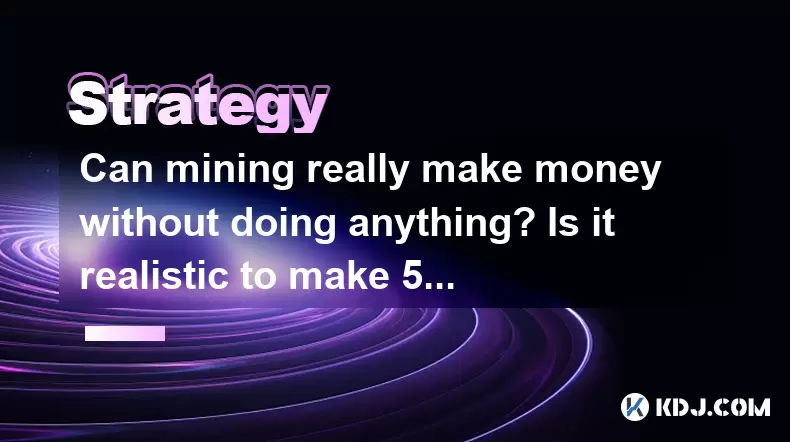-
 bitcoin
bitcoin $123963.239194 USD
1.37% -
 ethereum
ethereum $4529.082464 USD
1.07% -
 xrp
xrp $2.983640 USD
0.71% -
 tether
tether $1.000287 USD
0.02% -
 bnb
bnb $1179.874393 USD
2.99% -
 solana
solana $230.633678 USD
1.55% -
 usd-coin
usd-coin $0.999835 USD
0.03% -
 dogecoin
dogecoin $0.254240 USD
1.34% -
 tron
tron $0.341176 USD
0.15% -
 cardano
cardano $0.842285 USD
0.52% -
 hyperliquid
hyperliquid $48.537896 USD
-0.86% -
 chainlink
chainlink $21.863092 USD
-0.84% -
 ethena-usde
ethena-usde $0.999743 USD
-0.07% -
 sui
sui $3.579561 USD
-0.18% -
 stellar
stellar $0.403418 USD
2.67%
Can mining really make money without doing anything? Is it realistic to make 5,000 yuan a day?
Cryptocurrency mining requires significant setup and maintenance, making it unrealistic to earn 5,000 yuan daily without active involvement and substantial initial investment.
Jun 02, 2025 at 02:22 pm

The allure of making money without doing anything has led many to explore cryptocurrency mining. The question on many minds is whether it's truly possible to earn significant sums, such as 5,000 yuan a day, simply by mining. To understand this, we need to delve into the mechanics of mining, the costs involved, and the realistic potential for profit.
What is Cryptocurrency Mining?
Cryptocurrency mining is the process by which transactions are verified and added to the public ledger, known as the blockchain. Miners use powerful computers to solve complex mathematical problems, and in return, they are rewarded with cryptocurrency. The most well-known cryptocurrency that can be mined is Bitcoin, but there are many others, such as Ethereum, Litecoin, and Monero.
How Does Mining Generate Income?
Miners earn income in two primary ways: block rewards and transaction fees. When a miner successfully solves a block, they are awarded a certain amount of cryptocurrency. For instance, Bitcoin miners currently receive 6.25 BTC per block. Additionally, miners can collect transaction fees from the transactions included in the block they mine. These fees are paid by users to prioritize their transactions on the blockchain.
Can Mining Really Be Done Without Doing Anything?
The idea of mining without doing anything is a misnomer. Mining requires significant initial setup and ongoing maintenance. To start mining, you need to invest in hardware, such as ASICs (Application-Specific Integrated Circuits) for Bitcoin or GPUs (Graphics Processing Units) for other cryptocurrencies. Additionally, you'll need to cover electricity costs, which can be substantial depending on your location and the efficiency of your mining equipment.
Once the setup is complete, the mining process can be automated to some extent. Software can be configured to run continuously, solving mathematical problems and attempting to mine blocks. However, this does not mean you can simply set it and forget it. Regular maintenance is required to ensure the hardware is running efficiently, and you need to monitor the profitability of your mining operation to adjust strategies as needed.
Is It Realistic to Make 5,000 Yuan a Day?
Earning 5,000 yuan a day from mining is a lofty goal that depends on several factors. The current price of the cryptocurrency you're mining, the efficiency of your hardware, and the cost of electricity are crucial. To achieve such a high daily income, you would need to mine a significant amount of cryptocurrency each day.
Let's break down the math for Bitcoin mining as an example. If Bitcoin's price is 300,000 yuan, you would need to mine approximately 0.0167 BTC per day to reach 5,000 yuan. With the current block reward of 6.25 BTC and assuming you mine a block every 10 minutes, you would need to solve around 2.4 blocks per day, which is highly unrealistic for an individual miner.
For other cryptocurrencies like Ethereum, the calculations would be different but still challenging. The mining difficulty and the number of miners competing for the same rewards make it increasingly difficult to achieve such high daily earnings.
Costs and Profitability
To assess whether mining can be profitable, you need to consider the costs involved. The initial investment in hardware can range from a few hundred to tens of thousands of yuan, depending on the scale of your operation. Electricity costs can also be a significant factor, especially in regions where electricity is expensive.
To determine profitability, you need to calculate your daily earnings and subtract your daily costs. Profitability calculators are available online and can help you estimate your potential earnings based on your hardware and electricity costs. However, these calculators are based on current conditions and may not account for future changes in cryptocurrency prices or mining difficulty.
Alternative Mining Methods
Cloud mining is another option that some consider as a way to mine without the hassle of managing hardware. Cloud mining involves renting mining power from a company that operates the hardware. This can be a more accessible entry point for those who don't want to deal with the complexities of setting up and maintaining their own mining rigs.
However, cloud mining comes with its own set of risks. The legitimacy of some cloud mining providers has been questioned, and there have been instances of scams. Additionally, the fees charged by cloud mining services can eat into your potential profits, making it challenging to achieve high daily earnings like 5,000 yuan.
Frequently Asked Questions
Q: Can I start mining with a regular computer?A: While it's technically possible to mine with a regular computer, it's not practical for most cryptocurrencies. Bitcoin mining, for example, requires specialized ASIC hardware due to the high computational power needed. For other cryptocurrencies like Ethereum, a high-end GPU might suffice, but the profitability would still be low compared to dedicated mining rigs.
Q: How long does it take to recoup the initial investment in mining hardware?A: The time it takes to recoup your investment depends on several factors, including the price of the cryptocurrency you're mining, your electricity costs, and the efficiency of your hardware. In some cases, it can take several months to a year or more to break even. It's important to do thorough research and use profitability calculators to estimate your potential return on investment.
Q: Is it better to join a mining pool or mine solo?A: Joining a mining pool can increase your chances of earning a consistent income, as you'll be working with other miners to solve blocks. The rewards are shared among pool members based on their contributed mining power. Mining solo can be more rewarding if you manage to solve a block on your own, but it's also riskier and less predictable. The choice depends on your risk tolerance and mining goals.
Q: Can I mine multiple cryptocurrencies at the same time?A: Yes, it's possible to mine multiple cryptocurrencies simultaneously, but it depends on your hardware. Some mining rigs can be configured to switch between different cryptocurrencies based on profitability. However, this requires more advanced setup and management, and the efficiency of mining multiple cryptocurrencies at once may vary.
Disclaimer:info@kdj.com
The information provided is not trading advice. kdj.com does not assume any responsibility for any investments made based on the information provided in this article. Cryptocurrencies are highly volatile and it is highly recommended that you invest with caution after thorough research!
If you believe that the content used on this website infringes your copyright, please contact us immediately (info@kdj.com) and we will delete it promptly.
- BlockDAG, DOGE, HYPE Sponsorship: Crypto Trends Shaping 2025
- 2025-10-01 00:25:13
- Deutsche Börse and Circle: A StableCoin Adoption Powerhouse in Europe
- 2025-10-01 00:25:13
- BlockDAG's Presale Buzz: Is It the Crypto to Watch in October 2025?
- 2025-10-01 00:30:13
- Bitcoin, Crypto, and IQ: When Genius Meets Digital Gold?
- 2025-10-01 00:30:13
- Stablecoins, American Innovation, and Wallet Tokens: The Next Frontier
- 2025-10-01 00:35:12
- NBU, Coins, and Crypto in Ukraine: A New Yorker's Take
- 2025-10-01 00:45:14
Related knowledge

Practical parameter settings for a Bitcoin multi-timeframe moving average system
Sep 18,2025 at 10:54pm
Optimizing Timeframe Combinations for Bitcoin Trading1. Selecting appropriate timeframes is crucial when building a multi-timeframe moving average sys...

How can I filter out false breakouts in Dogecoin high-frequency trading?
Sep 22,2025 at 01:00am
Understanding False Breakouts in Dogecoin Trading1. A false breakout occurs when Dogecoin's price appears to move beyond a defined support or resistan...

Techniques for identifying tops and bottoms in the Bitcoin on-chain NVT model
Sep 20,2025 at 07:54pm
Understanding the NVT Model in Bitcoin Analysis1. The Network Value to Transactions (NVT) ratio is often described as the 'P/E ratio' of the cryptocur...

What does the surge in open interest in Bitcoincoin futures mean?
Sep 20,2025 at 11:18pm
Understanding the Surge in Dogecoin Futures Open Interest1. A surge in open interest within Dogecoin futures indicates a growing number of active cont...

How can I use the Ethereum USDT premium to gauge market sentiment?
Sep 18,2025 at 11:55pm
Understanding the Ethereum USDT Premium1. The Ethereum USDT premium refers to the price difference between USDT (Tether) traded on Ethereum-based plat...

What should I do if Ethereum staking yields decline?
Sep 20,2025 at 06:18am
Understanding the Causes Behind Declining Ethereum Staking Yields1. The Ethereum network transitioned to a proof-of-stake consensus mechanism with the...

Practical parameter settings for a Bitcoin multi-timeframe moving average system
Sep 18,2025 at 10:54pm
Optimizing Timeframe Combinations for Bitcoin Trading1. Selecting appropriate timeframes is crucial when building a multi-timeframe moving average sys...

How can I filter out false breakouts in Dogecoin high-frequency trading?
Sep 22,2025 at 01:00am
Understanding False Breakouts in Dogecoin Trading1. A false breakout occurs when Dogecoin's price appears to move beyond a defined support or resistan...

Techniques for identifying tops and bottoms in the Bitcoin on-chain NVT model
Sep 20,2025 at 07:54pm
Understanding the NVT Model in Bitcoin Analysis1. The Network Value to Transactions (NVT) ratio is often described as the 'P/E ratio' of the cryptocur...

What does the surge in open interest in Bitcoincoin futures mean?
Sep 20,2025 at 11:18pm
Understanding the Surge in Dogecoin Futures Open Interest1. A surge in open interest within Dogecoin futures indicates a growing number of active cont...

How can I use the Ethereum USDT premium to gauge market sentiment?
Sep 18,2025 at 11:55pm
Understanding the Ethereum USDT Premium1. The Ethereum USDT premium refers to the price difference between USDT (Tether) traded on Ethereum-based plat...

What should I do if Ethereum staking yields decline?
Sep 20,2025 at 06:18am
Understanding the Causes Behind Declining Ethereum Staking Yields1. The Ethereum network transitioned to a proof-of-stake consensus mechanism with the...
See all articles










































































